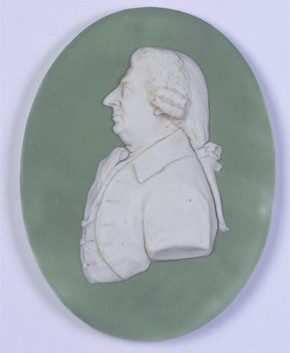The Lost Bust of James 'Athenian' Stuart (1767)
The Society of Artists of Great Britain opened their 1767 exhibition on April 22. During this, their eighth year, they hosted their show at the Great Room in Spring-Garden, Charing Cross. [1] The printed catalogue lists the paintings, drawings, sculptures, and prints that its members displayed. On one of the first days of the exhibition, a clay bust, supposedly by the sculptor James Moore, fell from its bracket in the corner of the room, shattering at the feet of the person it represented. The St. James's Chronicle reported the following:
The Publick may rely on the following as Fact.--In two or three Days after opening the present Exhibition of Painting, Sculpture, &c. at the Great Room in Pall-Mall, a very fine Clay Bust, of J[ame]s Stuart, Esq; Architect, standing on Brackets in one Corner of the Room, suddenly bowed forward, tumbled from its Station, and broke into a Multitude of Pieces. So far there is nothing wonderful in this Anecdote; but what renders the Circumstance remarkable, is, that the Accident happened while Mr. S[tuart] himself was viewing it, with many other Gentlemen and Ladies Present; and it is incontestable that no Person whatever touched the Figure; nothing external approached it; nor has it been yet discovered, though the most strict Examination has been made, from what Cause this odd Effect was produced.--The Bust was the Workmanship of Mr. [James] Moore; it bore a very striking Resemblance of the Gentleman above-named; and was deemed a very valuable Performance. Among the old Romans, who were as superstitious as they were brave, such an Accident would have been regarded as extremely ominous. [2]
A sculpture of the architect James 'Athenian' Stuart -- now a minor celebrity because of his publication of The Antiquities of Athens (1763) -- it was not listed in the 1767 catalog or Algernon Graves' catalog of the organization's exhibitors. Nor is the bust mentioned in biographies of James Stuart.
It was an unfortunate event, both for Moore and Stuart. And, only a few images of Stuart survive, including his self-portraits in gouache (RIBA) and in Antiquities of Athens. Additionally, we have a few images of him at the height of his fame.

Wedgwood and Bentley. Portrait medallion of James Stuart. after 1777. The Wedgwood Museum Trust, Barlaston, Staffordshire

WC Edwards after Richard Brettingham. James 'Athenian' Stuart. engraving. Victoria and Albert Museum.

James Stuart Attributed to Philip Jean. James Stuart. ca. 1780. watercolour and bodycolour on ivory. 54 x 44 mm. NPG 55a
 Samuel William Reynolds after an unknown artist. James Stuart. 1795. etching. 225 mm x 178 mm. NPG D8967
Samuel William Reynolds after an unknown artist. James Stuart. 1795. etching. 225 mm x 178 mm. NPG D8967
Perhaps the most interesting image was by William Hogarth in his Five Orders of Perriwigs, a print that still awaits a sustained analysis that builds on Ronald Paulson's insights.

William Hogarth. The Five Orders of Perriwigs. 1761. etching. 297 x 221 mm. British Museum of Prints and Drawings.
[1] A catalogue of the pictures, sculptures, designs in architecture, models, drawings, prints, &c. exhibited at the great room in Spring-Garden (London, 1767), title page.
[2] St. James's Chronicle or the British Evening Post, no. 963 (2-5 May 1767).
[Note: I originally published this post on Tumblr on 26 January 2012]
